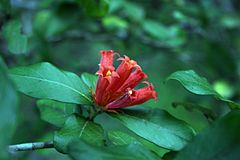Burchellia bubalina
| Burchellia bubalina subsp. var. | ||||||||||||||||||||||||||||||||||||||||||||||||||||||||
|---|---|---|---|---|---|---|---|---|---|---|---|---|---|---|---|---|---|---|---|---|---|---|---|---|---|---|---|---|---|---|---|---|---|---|---|---|---|---|---|---|---|---|---|---|---|---|---|---|---|---|---|---|---|---|---|---|

|
|
| ||||||||||||||||||||||||||||||||||||||||||||||||||||||
| ||||||||||||||||||||||||||||||||||||||||||||||||||||||||
Burchellia is a genus in the family Rubiaceae, native to the Cape floristic region of southernmost Africa. It contains a single species, Burchellia bubalina, commonly named the "wild pomegranate" (English) or wildegranaat (Afrikaans).[1] The species is widely cultivated in frost-free gardens as an ornamental tree, and has become a weed in some regions.[2]
A small shrub or tree to 8 metres, the species has red flowers, grey-green bark and dark green leaves.
This name was revised by John Sims in the species' first description in Curtis's Botanical Magazine in 1822. He gives this account of the earlier taxonomic history:
- "In the Supplementum Plantarum of the younger Linnæus this plant was referred to the genus Lonicera, but as it belongs to the natural order of Rubiaceae it will by no means associate with that genus. Persoon joined it with Swartz's Cephælis, the Tapocomea of Aublet and Bernard de Jussieu; but Mr. Brown not finding it to accord with any established genus, has considered it as distinct from any, and given it the name of Burchellia in honour of Mr. Burchell, a very enterprising traveller in Southern Africa, who has favoured the public with an interesting account of his travels in that country. And, certainly, persons who, in spite of deprivations and difficulties, spend a large portion of their valuable time in such hazardous undertakings, for the promotion of science, merit this only reward of the botanist; but we can by no means approve of altering the specific name, which, when once established, should remain inviolate, except for very particular reasons; we have therefore thought it right to restore the name of bubalina."
Following the formal description, he wrote as follows:
- Burchellia bubalina is a native of the Cape of Good Hope, where it is called Buffelhorn or Buffaloe-Horn, a name given it by the colonists from the extreme hardness of its wood. Flowers in the spring or summer. Requires to be protected from frost and we believe has seldom blossomed in this country without the assistance of the heat of the stove. Communicated by Messrs. Loddiges and Sons.
The name of the genus was given in honour of William John Burchell, an African explorer.
| Standard Cyclopedia of Horticulture |
|---|
|
Burchellia (W. Burchell, botanical traveler). Rubiaceae. One species from S. Afr., an evergreen shrub. with opposite short-petioled Lvs. and dense terminal clusters of sessile scarlet fls.: corolla tubular, bell-shaped; stamens 5, inserted in the tube: fr. a 2-celled, many-seeded berry. B. capensis, R. Br., has been in the American trade, being cult, for its rich, dark foliage and brilliant fls. It is very variable, and has received several names. Three to 10 ft. Prop, by cuttings. Grown under glass.
|
Cultivation
Propagation
Pests and diseases
Varieties
Gallery
References
- Standard Cyclopedia of Horticulture, by L. H. Bailey, MacMillan Co., 1963
External links
- w:Burchellia bubalina. Some of the material on this page may be from Wikipedia, under the Creative Commons license.
- Burchellia bubalina QR Code (Size 50, 100, 200, 500)
Cite error:
<ref> tags exist, but no <references/> tag was found
